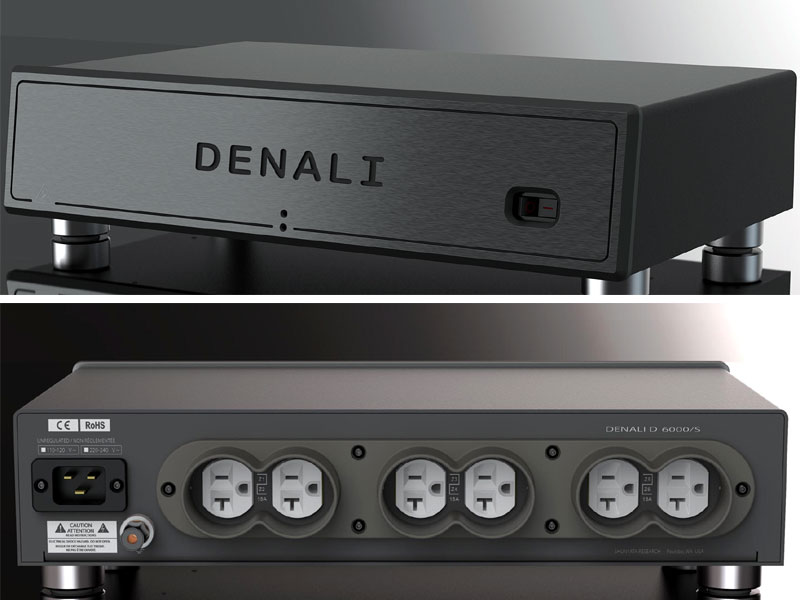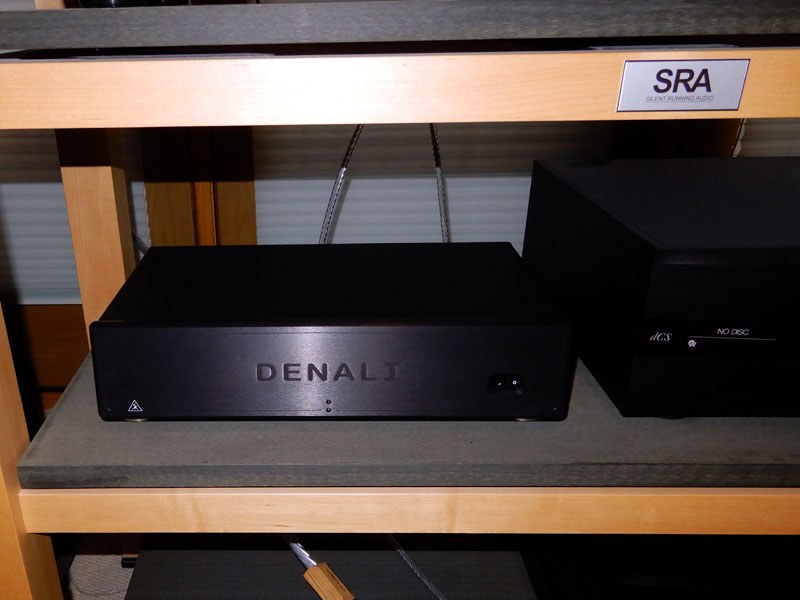First Sounds: Shunyata Research Denali D6000/S v2
few months ago, I had a philosophical discussion with a close friend about the current state of the audio industry. This friend is a veteran audiophile with keen insight -- someone with whom I have had many philosophical discussions. We were lamenting high-end audio’s place within our current culture, and my friend made an interesting observation about the people who design and build products today: “We need a new crop of Jason Blooms and Dave Wilsons, and a few crazies like Mark Levinson and a couple of grounded sensibles like William Conrad and Lew Johnson on the scene.” This led to a question: Who are those people today? Who are the designers of audio equipment that not only makes recorded music sound more like the live thing but also have done so in a completely original way, pushing the technological rock further down the audio road? One name came immediately to mind: Caelin Gabriel, the head of Shunyata Research. He fits the profile of those audio luminaries of yesteryear, and not just because he has built a successful audio company (and medical-device company). While Shunyata Research has more recently garnered praise for its signal-carrying cables, it was founded on Gabriel’s original approach to purifying AC power, first through his power cords and then his power distributors and conditioners. As much as what Gabriel has done, I think, is why he has done it, which grew out of a few salient personal traits. The first is that he’s an independent thinker with original ideas about how to purify the audio signal. Second, he has a desire to explain and codify what he does. Finally, he is a longtime audiophile; creating audio products that make a sonic difference is not just an academic exercise for him -- it’s something he does because it fascinates him and makes his own system sound better. Dave Wilson used to famously say, “I make speakers that I like, and fortunately other people like them too.” Caelin Gabriel could say the same about his cables and conditioners. I’ve written about many Shunyata products over the years, and even now I can’t imagine listening without them. All of that experience has led me to understand Caelin Gabriel’s method, boiling it down to three important precepts. First, when it comes to power conditioning, Gabriel wants to do no harm. His products employ no transformers or regenerators; they are totally passive, simply filtering the AC as it passes through them instead of trying to reconstitute it between input and output. Second, as discussed above, he believes in measurable performance, perhaps as the outgrowth of a desire to take his products, and the entire category in which they reside, from out of the purely subjective realm and to ensure that results are repeatable. Finally, he has often been able to improve his products over time while also lowering their prices. This has happened with his power conditioners, but especially with his power cords, he has espoused this less-and-more approach. This is a definite sign of an important audio maker, one whose work progresses over time because it is not specifically tied to the creation of a product line. It’s first and foremost about the technology and pushing it forward. Back in late 2016, Vance Hiner wrote about Shunyata Research's Denali line, and it seemed like these new and less expensive power-conditioning products were about to turn the entire market segment on its head. They were not only the latest thing from Shunyata Research, an established leader in the field of power purification, but they cost less than so much of their competition. I wrote a sidebar to that review in which I called the Denali 2000/T and 6000/T "the peak of power conditioning here and now."
It comes as no surprise, therefore, that Caelin Gabriel has eclipsed his original Denali line, deciding to call the replacement “v2,” although I personally think the improvement is great enough, both on paper and in the music, to warrant a completely new name. The first product is the Denali D6000/S v2 ($4500), a six-outlet unit that has all of Shunyata’s proprietary features and processes discussed in Vance’s review but adds some important new wrinkles. The first, and possibly the most significant, is the use of an oversized filter network originally developed for Shunyata’s medical division -- but with a twist. While that network was designed for maximum noise reduction, the new one has been refined to also allow maximum throughput of instantaneous current -- what amplifiers need. Further, while each pair of outlets for the original Denali units had one filter, now each outlet has its own filter, and all are rated for high-current throughput. Finally, the v2 unit adds a ground-plane noise-reduction system. The combined effect of the improved filter network and ground-plane isolation has lead to an overall noise-reduction measurement of -68dB at 1mHz. For context, almost all power-conditioners, including Shunyata's recently discontinued Triton v3, measure between 24 to 28dB down at 1mHz. Summing up these enhancements, Grant Samuelsen of Shunyata said, "Our Triton v3 was better with current and the original Denali was better with noise reduction. The Denali v2 now combines Triton v3 -like high-current capability with superior noise reduction.” I used a single Denali D6000/S v2, designed to rest on the shelf of an audio rack. Shunyata has confirmed that a more expensive eight-outlet vertical tower model, made to sit beside or behind a rack, is coming early in 2020. The Denali D6000/S v2 is smaller than Shunyata's previous reference, the Hydra Triton v3 ($9000), especially when that unit doesn't include the also recently retired Typhon QR add-on supercharger ($9000) -- "supercharger" is my term, not one Caelin Gabriel, who is painfully circumspect and a racing buff, would use.
As I've mentioned, I've used Shunyata power products for years -- all the way back to the original Corian-clad Hydra and through more than one model of the Triton. Even so, the Denali D6000/S v2, which couldn't quite accommodate my entire system but was suitable for a subset of my electronics (preamp, mono amps, universal digital player, phono stage and turntable; or dCS Rossini stack and mono amps), is a revelation, a music-clarifying machine that simply made listening a more natural experience, and it displays no deleterious sonic effects -- zilch, zero, zip. With the D6000/S v2, instrumental lines are more clearly delineated and purer throughout their range. The music sounds more effortless, detailed and dynamic. This last thing may seem counterintuitive, given the dynamic limitations of some other very good power products, but it's true. I suspect this dynamic prowess is related to the stunning clarity the Denali D6000/S v2 brings, the music sounding more like itself and less the product of a complex and expensive chain of electronics. With the Denali D6000/S v2, listening is like breathing; it's not something I have to concentrate on -- the music just happens. And so it was with both digital and analog. I've explained in the past my listening to the same recording in different formats, which tells me a great deal not only about the differences in the formats themselves but also the playback hardware. There are certain recordings, like some of Telarc's early Soundstream recordings, that I have in three different forms: CD, SACD and LP. One of these, a true sonic spectacular, is Stravinsky's The Rite of Spring. The CD [CD-80039] is of showoff quality, with the SACD [SACD-60039] and LP [DG-10039] displaying what could be considered incremental differences overall, but those differences sounded more fundamental with the D6000/S v2 in the system. That is, the purity of string tone and the abrupt dynamic shifts were vivid and startling, able to approximate the immediacy of the live event. It wasn't so much that there was more music but rather less of any amusical artifacts -- the effects of the AC feeding the system. Again, the D6000/S v2 was designed not only for maximum filtration but also maximum current delivery. Unfettered describes both the D6000/S v2's function and the sound I heard. One question I had about the Denali D6000/S v2 is how it
would affect the sale of Shunyata's Triton v3, which was the company's top of the line.
However, Shunyata answered my question by recently discontinuing the Triton v3. My sense,
from speaking to Grant Samuelsen, is the title of "reference" will now be shared
by the Denali D6000/S v2 and the soon-to-be-released eight-outlet Tower Denali. Perhaps
this is another trait of an important audio designer -- the willingness to retire an
established product in favor of a less expensive one with even better performance. The
Denali D6000/S v2 may be tucked into the middle of Shunyata Research's current product
lineup, but it's a true reference-level power conditioner without a true reference-level
price. It gets my vote for Caelin Gabriel's best product yet. |


